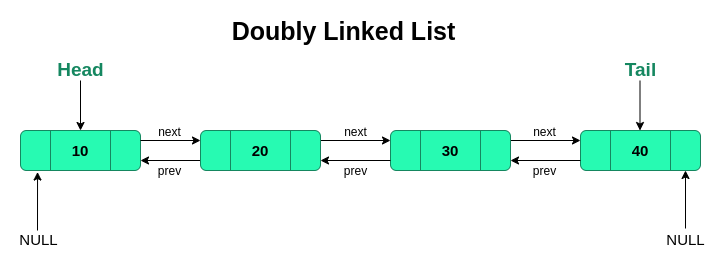How to Create a Doubly Linked List in C?
Last Updated :
06 Mar, 2024
A doubly linked list is a type of linked list in which each node has two links. The first link points to the previous node in the list while the second link points to the next node in the list. In other words, navigation in a doubly linked list is possible from both sides, from the front as well as the back. In this article, we will learn how to create a doubly linked list in C.
What is a Doubly Linked List?
In a singly linked list, each node has only one link which points to the node next to it. For this reason, we can traverse it from one side only and we cannot traverse back and forth. To solve this problem doubly linked list is used where each node contains a link to the next as well as the previous node.

How We Can Create a Doubly Linked List in C?
To create a Doubly Linked List in C, you need to define a structure that represents each node in the list. Each node should contain pointers to the previous and next nodes. Then, you can define functions to perform operations such as insertion, deletion, and traversal on the doubly linked list.
1. Representation
The doubly linked list node can be represented as a structure in C language. The below structure represents the minimal doubly linked list:
typedef struct node {
int data;
struct node* next;
struct node* prev;
} Node;
Here,
- data: data field of the node.
- next: pointer to the next node.
- prev: pointer to the prev node.
The nodes at the ends (i.e. does not have a previous or next node) will be set as NULL.
We can then use this data type with malloc() to dynamically create the instances of the doubly linked list node and then join them inside insertion operations.
The whole doubly linked list will be represented as the pointer to the head node (i.e. starting node) as all the nodes can be traversed using this node. We can also maintain a pointer to the end node for our convenience.
2. Basic Operations
The basic operations that are performed on the double linked list in this program are as follows:-
|
Operation
|
Description
|
Time Complexity
|
Space Complexity
|
|
Insert_at_head
|
Adding an element to the beginning of the doubly linked list.
|
O(1)
|
O(1)
|
|
Delete_at_head
|
Deleting an element from the beginning of the doubly linked list.
|
O(1)
|
O(1)
|
|
Insert_at_tail
|
To add an element to the end of the doubly linked list.
|
O(1), if we have pointer to tail, otherwise O(N).
|
O(1)
|
|
Delete_at_tail
|
Delete an element from the end of the doubly linked list.
|
O(1), if we have pointer to tail, otherwise O(N).
|
O(1)
|
|
Display forward
|
To display the entire doubly linked list in a forward manner.
|
O(N)
|
O(1)
|
|
Display backwards
|
To display the entire doubly linked list in a backward manner.
|
O(N)
|
O(1)
|
C Program to Create a Doubly Linked List in C
C
#include <stdio.h>
#include <stdlib.h>
struct node {
int data;
struct node* next;
struct node* prev;
};
struct node* head = NULL;
struct node* tail = NULL;
struct node* create_node(int data)
{
struct node* new_node
= (struct node*)malloc(sizeof(struct node));
new_node->data = data;
new_node->next = NULL;
new_node->prev = NULL;
return new_node;
}
void insert_at_head(int data)
{
struct node* new_node = create_node(data);
if (head == NULL) {
head = new_node;
tail = new_node;
}
else {
new_node->next = head;
head->prev = new_node;
head = new_node;
}
}
void insert_at_tail(int data)
{
struct node* new_node = create_node(data);
if (tail == NULL) {
head = new_node;
tail = new_node;
}
else {
new_node->prev = tail;
tail->next = new_node;
tail = new_node;
}
}
void delete_at_head()
{
if (head == NULL) {
return;
}
struct node* temp = head;
if (head == tail) {
head = NULL;
tail = NULL;
}
else {
head = head->next;
head->prev = NULL;
}
free(temp);
}
void delete_at_tail()
{
if (tail == NULL) {
return;
}
struct node* temp = tail;
if (head == tail) {
head = NULL;
tail = NULL;
}
else {
tail = tail->prev;
tail->next = NULL;
}
free(temp);
}
void display_forward()
{
struct node* current = head;
while (current != NULL) {
printf("%d ", current->data);
current = current->next;
}
printf("\n");
}
void display_backward()
{
struct node* current = tail;
while (current != NULL) {
printf("%d ", current->data);
current = current->prev;
}
printf("\n");
}
int main()
{
insert_at_head(10);
insert_at_head(20);
insert_at_tail(30);
display_forward();
display_backward();
delete_at_head();
delete_at_tail();
display_forward();
display_backward();
return 0;
}
|
Output
20 10 30
30 10 20
10
10
Share your thoughts in the comments
Please Login to comment...